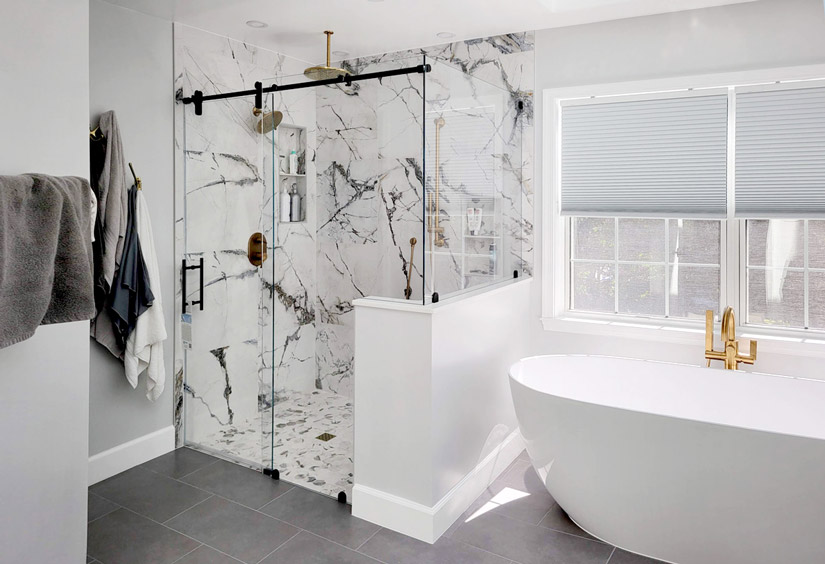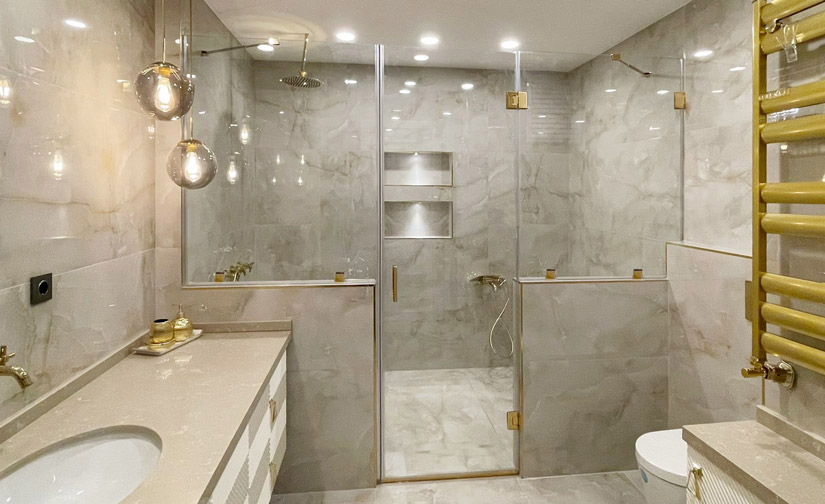
These days, remodeling a bathroom often includes ordering a frameless glass shower enclosure. This is an absolutely gorgeous bathroom fixture that’s a significant investment into your home, so getting the design right is critical. Looking at photos of designer bathrooms is a good way to start the creative juices flowing, but you also want the layout to be functional and reasonably easy to maintain. The ABC Glass & Mirror team has not only designed and installed countless frameless showers, but we see many other shower enclosures when we visit homes for consultations. Our decades of combined experience have revealed a lot about what to do and what not to do in terms of frameless glass shower design. Save yourself from annoying and possibly costly pitfalls with these pro tips.
1. What is a frameless shower door?
2. Where can frameless glass showers be installed?
3. What types of frameless shower enclosures are available?
4. Which frameless enclosure option is right for my space?
5. What type of glass looks best on a frameless shower?
6. How should I style the items inside a clear frameless shower enclosure?
7. What are my options if I want a more private shower area?
8. What are common frameless shower door design fails?
9. What will make frameless shower doors easier to clean?
10. Can I get help designing my frameless glass shower?
11. What is the process for having a frameless shower installed?
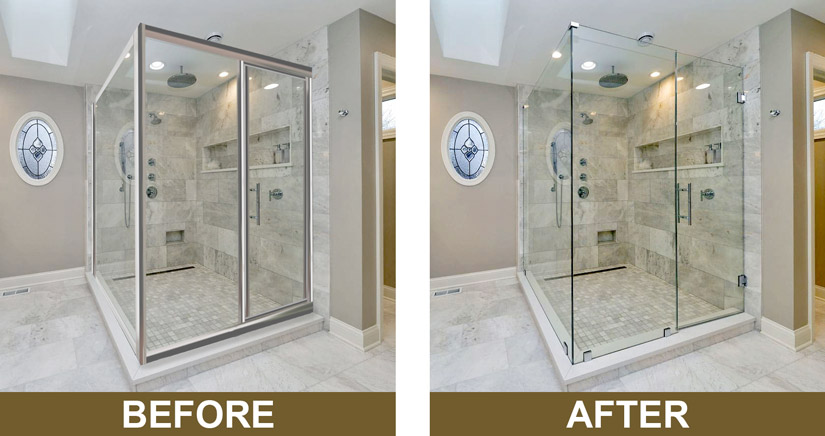
A frameless shower door is set apart from other products because the glass edges are not encased in aluminum framing. To provide appropriate rigidity in the absence of a framework, glaziers use thicker glass on frameless units. As with other glass showers, they are made from tempered glass to maintain a safe environment for shower users. Glass panels are joined to one another and to adjacent walls with hinges, small metal clips, and caulk joints. In some cases a header is installed across the top of the enclosure. This could be necessary or desirable for a few different reasons, such as:
Headers are typically made of metal, but ABC’s dual rolling door system is available with a header made of laminated tempered glass. As you can see in the video below, this product has undergone extreme tests of strength and durability.
Frameless glass can enclose a wide range of different bathing areas. Let’s take a look at some specific applications:

We’ve already discussed frameless corner showers above, so let’s look at some of the other possibilities:

Understanding a product’s features is one of the best ways to determine if it’s right for your particular space. Let’s look at the pros and cons of each option.
Frameless Glass Corner Shower

PRO: Makes use of two existing walls.

PRO: Can be right angle or neo-angle depending on available space and your preference. (A right angle enclosure forms a square or rectangle. A neo-angle enclosure has three glass sides – two coming out from the corner at 90 degree angles and another finishing the stall at 135 degree angles to the adjoining glass panels.)

CON: Sufficient clearance must be present for the door to swing open into the bathroom.
Frameless In-line Door and Panel

PRO: Works well for enclosing an existing bathtub or shower stall with glass.

PRO: Adds elegance to a tub/shower combo.

CON: Sufficient clearance must be present for the door to swing open into the bathroom.
Frameless French Doors

PRO: Great for elevating bathtub or shower stall with glass.

PRO: Double swinging doors add a touch of elegance and dress up the space.

CON: Clearance is needed for swinging door operation.
Single Frameless Door

PRO: Elevates a small shower stall.

CON: The door must be able to swing open without hitting or blocking another bathroom fixture.
Rolling “Barn Style” Frameless Door System

PRO: Space friendly and requires no clearance.

PRO: Can be added to a bathtub or shower.

CON: More moving parts and components to clean.
Frameless Shower Screen

PRO: Creates an open flow between bathroom and shower.

PRO: Simple design provides a lower price point.

CON: Water containment capability must be supplemented by appropriate floor slope, drain location, and shower spray placement.
Clear glass is the favorite choice for frameless glass showers. It promotes an open, flowing vibe within the bathroom while showcasing your shower tile and keeping the stall bright and airy. However, acid-etched, patterned, tinted, and cast glass are also available. We’ll answer some FAQs to help you determine which best suits your needs.

Are there other advantages to clear glass beyond what’s been discussed above?

Another plus to clear glass is its smooth, easy to clean surface.

I don’t like the greenish coloration around the edges of clear glass. Is there a way to minimize this?

Yes, this effect is minimized on ultra clear glass which has a lower iron content than standard clear glass.

Clear glass does look nice, but what if I want a more private shower area?

To create a more secluded glass shower, choose acid-etched, frosted, tinted, or cast glass.

Can I have privacy glass with the easy to clean properties of clear glass?

Tinted glass provides some measure of privacy and has a smooth, easy-to-clean surface like clear glass.
Most homeowners go with clear glass, especially in the primary bathroom. It shows off the shower tile you’ve picked, but keep in mind that everything inside the shower will also be on display. No more pulling the curtain shut to hide the disarray of half empty shampoo bottles, damp washcloths, and the like. Here are a few tricks for keeping shower contents aesthetically pleasing.
If adding shower shelves isn’t an option for you at this point, you can still apply the other tips while arranging shower products on whatever surfaces you have available. My Domaine author Megan Beauchamp offers tips for organizing and styling the contents of small showers with limited storage options. She highlights helpful products like a stylish wood caddy that hangs from the shower head, a handy shower stool, and lots of shelves and holders that can be temporarily attached to your shower walls. Giving yourself adequate storage is the first and most crucial step to styling your shower area.
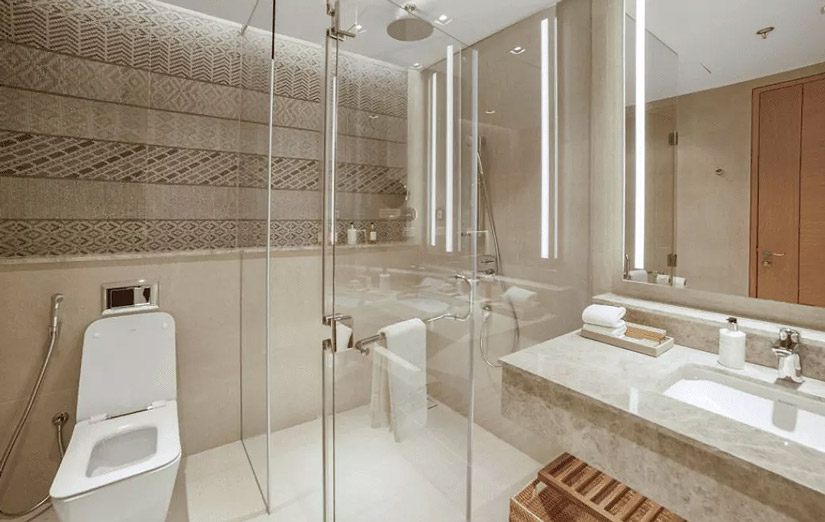
There are many reasons a homeowner might prefer a more secluded bathing area. Maybe the bathroom is shared by siblings, maybe you don’t want to worry about keeping the contents tidy, or maybe you just like a private shower stall. One option is to have the entire frameless shower built from vision obscuring glass – acid-etched, patterned, tinted, or cast. However, there are a few other possibilities to consider:

Taking a look at common shower design pitfalls can help you avoid annoying and potentially costly problems.

In the process of designing and ordering your frameless glass shower, you can make decisions that will make care and maintenance easier.
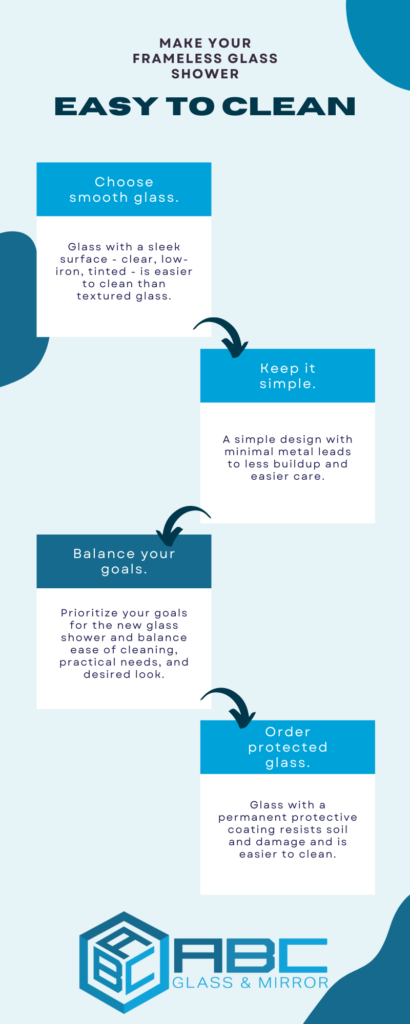
Yes, residents of the Northern Virginia area can set up a no-obligation complimentary consultation with a frameless glass shower technician from ABC Glass & Mirror. Having a glass shower professional inspect and measure your shower area and then discuss the best options for your space is one of the best ways to avoid common pitfalls. At this meeting, you will have the opportunity to:

After the meeting discussed above, you will receive a quote for the frameless shower enclosure and any custom options you are interested in. At this point, the next step is finalizing your decision and placing your order. We will then gather and prepare the glass and metal components of your shower door and set up a time for installation. A team of installers will put all the glass and metal in place and provide instructions for when the unit will be ready for ue. Benefits to having a custom frameless enclosure installed instead of using a DIY kit include:
Give us a call to learn more at (703)257-7150!
